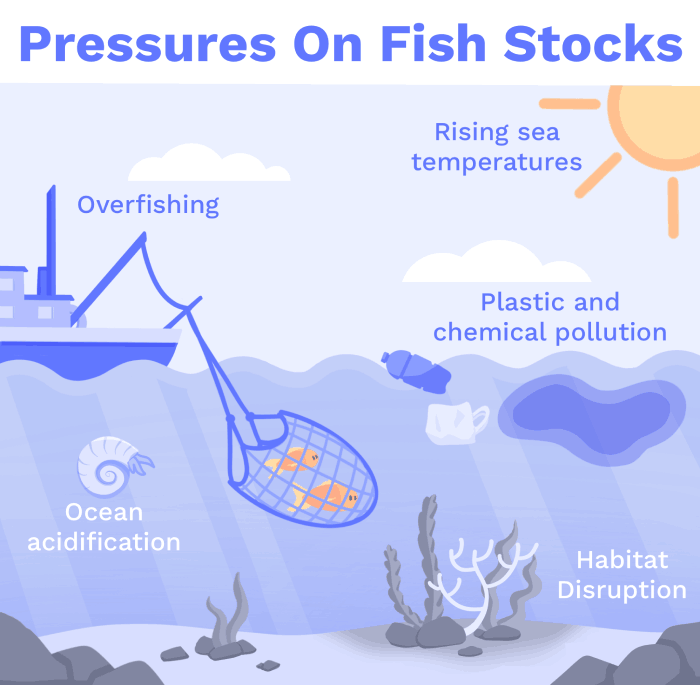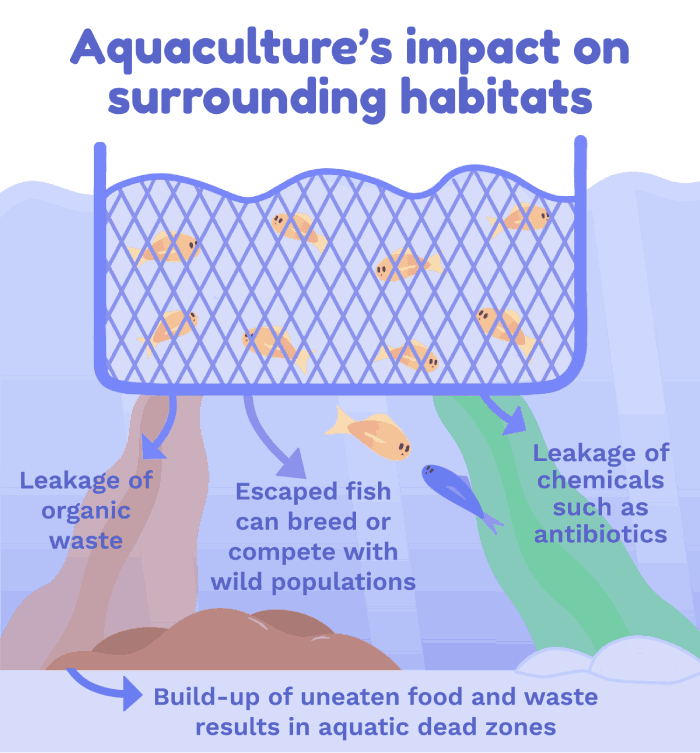Fish Farming: Is Eating Fish Sustainable?
8 minute read
Updated on: 10 Apr 2021

Pressures on fish stocks
What’s the problem with fishing?
Seafood is the most highly traded food worldwide, and is a primary source of protein for 20% of the world’s population
.
However, over a third of wild fish populations are overexploited. This means that fish are removed from the sea faster than they can reproduce
. Rising sea temperatures and ocean acidification, along with plastic and chemical pollution, make it even harder for fish to withstand the pressures of overfishing
. As a result, fish populations are shrinking
.
Although regulations have been put in place to conserve fish populations, they are often ignored by illegal fishing boats
.
Taking too many fish out of the sea disrupts food webs, causing populations of other vulnerable marine species to decline as well.
When predators are overfished, their plant-eating prey get out of hand and destroy large areas of underwater forest, releasing the carbon stored inside them.
Some fishing methods also cause stored carbon to be released from the sea floor. The most destructive is bottom trawling
.
What is bottom trawling?
Bottom trawling is a fishing technique that is used to catch fish from the seafloor, such as shrimp, prawns and cod. It involves dragging a big net across the seabed, catching everything in its path
.

Bottom Trawling
Why is bottom trawling particularly bad?
- Endangered, non-target species, such as sea turtles, are often caught in the net
.
- Trawl nets disturb the surface of the seafloor. This releases carbon that has been stored in the sediment for millennia, and reduces the capacity of these habitats to absorb carbon in the future
.
- By smoothing out the sediment, trawling reduces habitat diversity on the seafloor and limits the number of different species that can live there
.
It is clear to see that catching wild fish has devastating impacts on marine ecosystems. But how else can we source seafood?
Is farming fish better than catching wild fish?
Aquaculture is the farming of aquatic plants and animals. It is the fastest growing sector in animal food production, and provides over half of the fish we eat
.
Aquaculture is a key contributor to global food security and has the potential to reduce pressure on wild fish populations
. However, for some aquaculture practices, this is not the case…
What’s the problem with aquaculture?
Destroying habitats to make space for aquaculture directly harms natural ecosystems. Of particular concern is the destruction of mangrove forests (trees that grow in salty coastal water) to make way for shrimp farms. Mangrove forests provide coastal protection and nursery habitats for baby fish
. They also store a lot of carbon
. Losing these habitats, therefore, increases the release of carbon into the atmosphere
.
What’s more, wild fish are often used as feed for fish farms. Around 20% of fish harvested from the ocean are used to make fish feed. Indeed, carnivorous fish, such as salmon, consume up to 5 times more fish protein than they ultimately supply
.
Plant-eating fish don’t require fish-based feeds, and, therefore, don’t put such a strain on wild fish stocks. However, their feed often contains crop-plants, which require land, water, and energy to produce
.
Uneaten fish food, along with fish poo and other organic waste, can escape into surrounding habitats, creating aquatic dead zones where no wild fish can survive. Chemicals used in aquaculture, such as steroids, pesticides and antibiotics, may also leak into aquatic environments and interfere with local ecosystems
.

Aquaculture’s impact on surrounding habitats
Despite these problems, fish meat represents a healthy source of protein and essential fats and vitamins, with lower emissions, and higher efficiency, than other livestock such as beef and lamb. So what can we do to make aquaculture more sustainable?
Improving fish feed
The growth rates of fish can be improved without increasing how much they are fed. As fish need oxygen to digest their food, higher levels of oxygen in the water can increase fish growth. The same result can be achieved by using more easily digestible feed
.
Alternatively, the animals themselves can be selectively bred, or genetically engineered, to use feed more efficiently.

Energy loss through food chain
Even so, fish-eating species can be fed waste from the processing of fish for human consumption. This reduces pressures on wild fish stocks whilst reducing food waste. Microalgae can also be used instead of fish-based feed as they contain high levels of protein and the healthy fats found in fish meat
.
Some fish species don’t require humans to supply any feed at all! Filter-feeders, such as oysters and mussels, get food by straining nutrients out of the surrounding water, including nutrients from the waste of other fish
!
Can we improve fish health?
Better water quality and more nutritious feed improve fish health. This is important because disease is the biggest cause of production losses in aquaculture. Improving fish health will increase fish survival and the amount of fish produced from the same input of resources
.
The development of vaccines against most common fish diseases has enabled farmers to reduce their dependence on antibiotics. However, vaccines are only effective against certain diseases
.
Reducing pollution
Where a fish farm is built determines its impact on surrounding ecosystems. If too many farms are set up in the same area, pollutants such as fish waste and disease treatments will build up to dangerous levels
.
Alternatively, farms can be moved onto land to help contain waste and prevent fish escaping into the wild
.
Conclusion
With careful management, aquaculture can provide a healthy, sustainable source of animal protein, with lower emissions than other animal products. Even so, plant-based proteins almost always have a lower carbon footprint than meat. But what if we could make meat without all of the emissions associated with traditional livestock farming?

